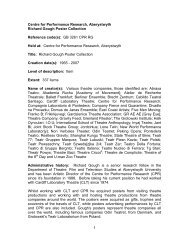- Page 1: Department of Analytical Chemistry
- Page 5: I would also like to thank the many
- Page 8 and 9: II Contents 3.2.1.2.2. The single-a
- Page 10 and 11: IV Contents 5.6.4.1. Comparison of
- Page 12 and 13: 2 Introduction the dating signal co
- Page 16 and 17: 6 Chapter 1 The luminescence signal
- Page 18 and 19: 8 Chapter 1 Figure 1.2: Energy-leve
- Page 20 and 21: 10 Chapter 1 The term • S × D re
- Page 22 and 23: 12 Chapter 1 The spontaneous signal
- Page 24 and 25: 14 Chapter 1 A number of natural do
- Page 26 and 27: 16 Chapter 1 Depending on the wavel
- Page 28 and 29: 18 Chapter 2 from quartz. This is q
- Page 30 and 31: 20 Chapter 2 Figure 2.2: OSL emissi
- Page 32 and 33: 22 Chapter 2 A set-up of the possib
- Page 34 and 35: 24 Chapter 2 Figure 2.5: Influence
- Page 36 and 37: 26 Chapter 2 where N is the number
- Page 38 and 39: 28 Chapter 2 charge in one way or a
- Page 40 and 41: 30 Chapter 2 2.5. Quartz OSL compon
- Page 42 and 43: 32 Chapter 2 The characteristics of
- Page 44 and 45: 34 Chapter 2 2.7. Sensitivity chang
- Page 46 and 47: 36 Chapter 2 As will be outlined in
- Page 48 and 49: 38 Chapter 2 2.8. Intrinsic lumines
- Page 50 and 51: 40 Chapter 2 seen when different su
- Page 52 and 53: 42 Chapter 2 The implication of the
- Page 54 and 55: 44 Chapter 2 Godfrey-Smith et al. (
- Page 56 and 57: 46 Chapter 2 On the contrary, in OS
- Page 58 and 59: 48 Chapter 2 lies in its relevance
- Page 61 and 62: 3.1. The age equation - CHAPTER 3 -
- Page 63 and 64: The optical dating method 53 Disadv
- Page 65 and 66:
The optical dating method 55 1994),
- Page 67 and 68:
The optical dating method 57 follow
- Page 69 and 70:
The optical dating method 59 The ca
- Page 71 and 72:
The optical dating method 61 3.2.1.
- Page 73 and 74:
The optical dating method 63 Step T
- Page 75 and 76:
The optical dating method 65 Figure
- Page 77 and 78:
The optical dating method 67 single
- Page 79 and 80:
The optical dating method 69 determ
- Page 81 and 82:
The optical dating method 71 Net OS
- Page 83 and 84:
The optical dating method 73 temper
- Page 85 and 86:
The optical dating method 75 3.2.2.
- Page 87 and 88:
The optical dating method 77 reprod
- Page 89 and 90:
The optical dating method 79 Figure
- Page 91 and 92:
The optical dating method 81 strong
- Page 93 and 94:
The optical dating method 83 3.2.3.
- Page 95 and 96:
The optical dating method 85 Figure
- Page 97 and 98:
The optical dating method 87 cause
- Page 99 and 100:
The optical dating method 89 theref
- Page 101 and 102:
The optical dating method 91 distri
- Page 103 and 104:
The optical dating method 93 instan
- Page 105 and 106:
The optical dating method 95 It can
- Page 107 and 108:
The optical dating method 97 OSL si
- Page 109 and 110:
The optical dating method 99 3.3. T
- Page 111 and 112:
The optical dating method 101 Figur
- Page 113 and 114:
The optical dating method 103 It is
- Page 115 and 116:
The optical dating method 105 expla
- Page 117 and 118:
The optical dating method 107 there
- Page 119 and 120:
The optical dating method 109 Becau
- Page 121 and 122:
The optical dating method 111 Figur
- Page 123 and 124:
The optical dating method 113 Atten
- Page 125 and 126:
The optical dating method 115 Final
- Page 127:
The optical dating method 117 Numbe
- Page 130 and 131:
120 Chapter 4 Figure 4.1: Location
- Page 132 and 133:
122 Chapter 4 Figure 4.2: Litho- an
- Page 134 and 135:
124 Chapter 4 former Late-glacial S
- Page 136 and 137:
126 Chapter 4 Age (ka) Lithostratig
- Page 138 and 139:
128 Chapter 4 Figure 4.3: The sampl
- Page 140 and 141:
130 Chapter 4 and the sand was wash
- Page 142 and 143:
132 Chapter 4 extremely well for se
- Page 144 and 145:
134 Chapter 4 not uncommon to obser
- Page 146 and 147:
136 Chapter 4 which the aliquots ca
- Page 148 and 149:
138 Chapter 4 necessary to obtain a
- Page 150 and 151:
140 Chapter 4 commercially availabl
- Page 152 and 153:
142 Chapter 4 Throughout this work,
- Page 154 and 155:
144 Chapter 4 inter-aliquot differe
- Page 156 and 157:
146 Chapter 4 OSL (normalised) 1.0
- Page 158 and 159:
148 Chapter 4 40 s at 125ºC. The f
- Page 160 and 161:
150 Chapter 4 D e (Gy) D e (Gy) 12
- Page 162 and 163:
152 Chapter 4 For samples OS-2 (Fig
- Page 164 and 165:
154 Chapter 4 Recovered / given dos
- Page 166 and 167:
156 Chapter 4 Risø (Gy) Ghent (Gy)
- Page 168 and 169:
158 Chapter 4 also put through a co
- Page 170 and 171:
160 Chapter 4 calibration spectrum
- Page 172 and 173:
162 Chapter 4 keV and 1764.5 keV) a
- Page 174 and 175:
164 Chapter 4 (h: OS-2) Equivalent
- Page 176 and 177:
166 Chapter 4 Spectrum analysis was
- Page 178 and 179:
168 Chapter 4 decay series are meas
- Page 180 and 181:
170 Chapter 4 Ratio NAA / low-level
- Page 182 and 183:
172 Chapter 4 Ratio field γ-spec.
- Page 184 and 185:
174 Chapter 4 • • D β D γ Th
- Page 186 and 187:
176 Chapter 4 Total Uncertainty (ka
- Page 188 and 189:
178 Chapter 4 Fink (2000) also appl
- Page 190 and 191:
180 Chapter 4 Indeed, in the assump
- Page 192 and 193:
182 Chapter 4 Number of Aliquots Nu
- Page 194 and 195:
184 Chapter 4 recycled OSL signals
- Page 196 and 197:
186 Chapter 4 indication that the s
- Page 198 and 199:
188 Chapter 4 agreement between the
- Page 200 and 201:
190 Chapter 4 Normalised K concentr
- Page 202 and 203:
192 Chapter 4 is planned. Further t
- Page 205 and 206:
- CHAPTER 5 - APPLICATION OF THE OP
- Page 207 and 208:
Application of the optical dating m
- Page 209 and 210:
Application of the optical dating m
- Page 211 and 212:
Application of the optical dating m
- Page 213 and 214:
Application of the optical dating m
- Page 215 and 216:
Application of the optical dating m
- Page 217 and 218:
Application of the optical dating m
- Page 219 and 220:
Application of the optical dating m
- Page 221 and 222:
Application of the optical dating m
- Page 223 and 224:
Application of the optical dating m
- Page 225 and 226:
Application of the optical dating m
- Page 227 and 228:
Application of the optical dating m
- Page 229 and 230:
Application of the optical dating m
- Page 231 and 232:
Application of the optical dating m
- Page 233 and 234:
Application of the optical dating m
- Page 235 and 236:
Application of the optical dating m
- Page 237 and 238:
Application of the optical dating m
- Page 239 and 240:
Application of the optical dating m
- Page 241 and 242:
Application of the optical dating m
- Page 243 and 244:
Application of the optical dating m
- Page 245 and 246:
Application of the optical dating m
- Page 247 and 248:
Application of the optical dating m
- Page 249 and 250:
Application of the optical dating m
- Page 251 and 252:
Application of the optical dating m
- Page 253 and 254:
Application of the optical dating m
- Page 255 and 256:
Application of the optical dating m
- Page 257 and 258:
Application of the optical dating m
- Page 259 and 260:
Application of the optical dating m
- Page 261 and 262:
Application of the optical dating m
- Page 263 and 264:
Application of the optical dating m
- Page 265 and 266:
Application of the optical dating m
- Page 267 and 268:
Application of the optical dating m
- Page 269 and 270:
Application of the optical dating m
- Page 271 and 272:
Application of the optical dating m
- Page 273 and 274:
Application of the optical dating m
- Page 275 and 276:
Application of the optical dating m
- Page 277 and 278:
Application of the optical dating m
- Page 279 and 280:
Application of the optical dating m
- Page 281 and 282:
Application of the optical dating m
- Page 283 and 284:
Application of the optical dating m
- Page 285 and 286:
SUMMARY AND CONCLUSIONS Luminescenc
- Page 287 and 288:
Summary and conclusions 277 observe
- Page 289 and 290:
Summary and conclusions 279 were fo
- Page 291 and 292:
- APPENDIX - A NOTE ON PAIRS COUNTI
- Page 293 and 294:
A note on pairs counting 283 in whi
- Page 295 and 296:
A note on pairs counting 285 Substi
- Page 297 and 298:
A note on pairs counting 287 same w
- Page 299:
A note on pairs counting 289 from c
- Page 302 and 303:
292 Nederlandse samenvatting sedime
- Page 304 and 305:
294 Nederlandse samenvatting 5%. Ov
- Page 306 and 307:
296 Nederlandse samenvatting in een
- Page 308 and 309:
298 Nederlandse samenvatting (binne
- Page 310 and 311:
II References Aitken M.J. (1998). A
- Page 312 and 313:
IV References Bailey R.M. (2002). S
- Page 314 and 315:
VI References Banerjee D., Murray A
- Page 316 and 317:
VIII References Bortolot V.J. (1997
- Page 318 and 319:
X References Bulur E. (1996). An al
- Page 320 and 321:
XII References Clarke M.L., Rendell
- Page 322 and 323:
XIV References Duller G.A.T. (1994a
- Page 324 and 325:
XVI References Felix C. and Singhvi
- Page 326 and 327:
XVIII References Galloway R.B. (199
- Page 328 and 329:
XX References Hossain S.M. and De C
- Page 330 and 331:
XXII References Jacobs Z., Duller G
- Page 332 and 333:
XXIV References KAYZERO/SOLCOI soft
- Page 334 and 335:
XXVI References Li S.-H. and Wintle
- Page 336 and 337:
XXVIII References McKeever S.W., Ag
- Page 338 and 339:
XXX References Murray A.S. (2000).
- Page 340 and 341:
XXXII References Murray A.S., Olley
- Page 342 and 343:
XXXIV References Prescott J.R. and
- Page 344 and 345:
XXXVI References Rieser U. (1991).
- Page 346 and 347:
XXXVIII References Schilles T., Poo
- Page 348 and 349:
XL References Spooner N.A. (1994b).
- Page 350 and 351:
XLII References Stoneham. D. and St
- Page 352 and 353:
XLIV References Van den haute P., V
- Page 354 and 355:
XLVI References Wagner G.A. (1998).
- Page 356 and 357:
XLVIII References Wintle A.G. and H
- Page 358:
L References Zander A., Duller G.A.



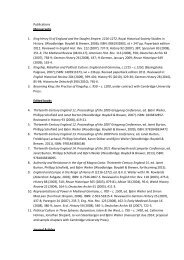
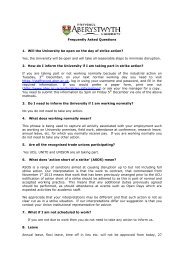



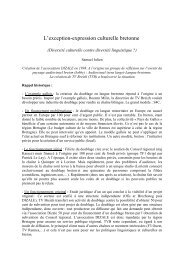

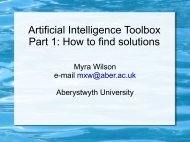


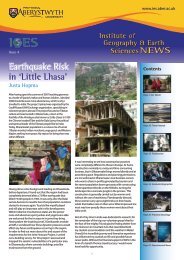
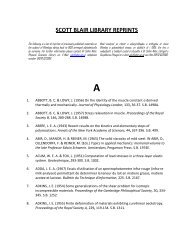
![[pdf] the council - Aberystwyth University](https://img.yumpu.com/8200062/1/184x260/pdf-the-council-aberystwyth-university.jpg?quality=85)
